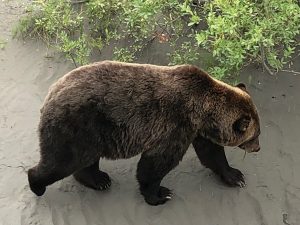We pointed the rental car south aiming for the Alaska Wildlife Conservation Center, which is near Portage, AK, and just before the start of the Kenai Peninsula. We had heard that this is where abandoned and abused and orphaned wildlife are cared for, often to live out their lives, so a visit to see up close some of what we had only seen from a distance seemed like a great idea.
On the way, we discovered some views of distant glaciers that we hadn’t noticed in the van, and we even stopped by to see Ken, the wildlife photographer who makes Bird Point his daily home. Kim spoke with him at length while I searched the horizon with some British tourists for Beluga whales in the Turnagain Arm. Ken’s “mission” is to make nature and wildlife more accessible to people, and he is heartened by visits from biology students or hearing about how his photographs brighten the day of those living in homes for the elderly. He gave Kim a package of his photos, and she may use them to create a book for her grandchildren to learn animal and bird names. Ken loved that idea.
The AWCC was amazing. There were moose, including a 3 month old baby, named Arnold, who’s mother was killed in a traffic accident in Anchorage, as well as some huge adults with enormous racks. We saw some grey wolves, and a baby black bear, shyly hanging out in a tree. There were fields of reindeer and elk and bison. Musk Ox looked like giant fur balls on the turf. Sitka deer are tiny compared to the ones roaming the lower 48. And there were 3 large brown bears — two sibling cubs (which were pretty big), and one larger one — calming eating grass as the tourists snapped photos. And a bald eagle who had lost its left wing to a bullet at some point. It’s hard to see these wild animals in enclosures, but clearly these were well cared for, and still out of doors, and their circumstances prevented them from returning to the wild.
From there we hung a left and headed towards Whittier, which is a tiny town that serves as the main port on this side of Prince William Sound. The only way to get there is through a one lane tunnel which is shared by both directions, and by a spur of the train line. So outbound is open on the half hour, and back on the hour. It’s a 2 1/2 mile tunnel, the road surface is the train track, and the walls are all exposed rock. At 20 MPH, it takes a little while to get through, and once there, we’re in a little seaside village, but with a deep enough harbor to house a huge Princess cruise ship. Prince William Sound encompasses 3,800 miles of coastline, bounded to the east and north by the Chugach Mountains and to the west by the Kenai Peninsula. Whittier was a perfect hideaway for the military to build a base during World War II. This deep water, ice free port was protected from air attacks due to the towering mountains that encircle Whittier which were also frequently covered by clouds. In 1943, a military facility named Camp Sullivan was completed and the port of Whittier became the entrance for United States soldiers entering Alaska.
We had lunch at the charming Swiftwater Cafe, strolled the shops and then headed back to make the 3PM entry to the tunnel.
We turned south on the Seward highway, keeping an eye open for our accommodation at Summit Lake Lodge, which is where we stayed on our first night on the road 10 days ago! (We didn’t realize that when we booked it, and are just pleased that it happens to be a good choice in this part of the world). We are settled into a cabin in the woods, and enjoying the internet and dinner in the lodge. Tomorrow we will head further south east and see what there is to see at the end of the road.









